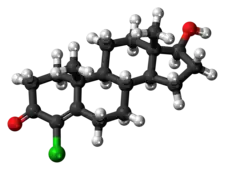Clostebol
Clostebol (INN; also known as 4-chlorotestosterone) usually as the ester clostebol acetate, is a synthetic anabolic–androgenic steroid (AAS). Clostebol is the 4-chloro derivative of the natural hormone testosterone. The chlorination prevents conversion to dihydrotestosterone (DHT) while also rendering the chemical incapable of conversion to estrogen. Although usually used as an ester including clostebol acetate (Macrobin, Steranabol, Alfa-Trofodermin, Megagrisevit), clostebol caproate (Macrobin-Depot), or clostebol propionate (Yonchlon), unmodified/non-esterified clostebol is also reported to be marketed, under the brand name Trofodermin-S in Mexico.[1]
 | |
 | |
| Clinical data | |
|---|---|
| Other names | Chlorotestosterone; 4-Chlorotestosterone; 4-Chloroandrost-4-en-17β-ol-3-one |
| Drug class | Androgen; Anabolic steroid |
| ATC code |
|
| Legal status | |
| Legal status |
|
| Identifiers | |
| |
| CAS Number | |
| PubChem CID | |
| DrugBank | |
| ChemSpider | |
| UNII | |
| KEGG | |
| ChEMBL | |
| CompTox Dashboard (EPA) | |
| ECHA InfoCard | 100.012.849 |
| Chemical and physical data | |
| Formula | C19H27ClO2 |
| Molar mass | 322.87 g·mol−1 |
| 3D model (JSmol) | |
| |
| |
| | |
Clostebol is a weak AAS with potential use as a performance enhancing drug. It is currently banned by the World Anti-Doping Agency.[2] Chlorodehydromethyltestosterone (Oral Turinabol), combining the chemical structures of clostebol and metandienone, was widely used in the East German state-sponsored doping program.[3]
Medical uses
Clostebol acetate ointment has ophthalmological and dermatological use.[4]
Side effects
Chemistry
Clostebol, also known as 4-chlorotestosterone or as 4-chloroandrost-4-en-17β-ol-3-one, is a synthetic androstane steroid and a derivative of testosterone. It is specifically the 4-chlorinated derivative of testosterone.
Society and culture
Nutritional supplements
A related anabolic steroid, methylclostebol, is a common additive in so-called dietary supplements, generally listed in the convoluted form 4-chloro-17α-methyl-androst-4-en-17β-ol-3-one.[5]
Publicized abuse cases
Use of clostebol has led to the suspension of a number of athletes in various sports including Freddy Galvis of the Philadelphia Phillies in 2012,[6] Dee Gordon of the Miami Marlins in 2016,[7] and Olympic athlete Viktoria Orsi Toth in 2016.[8]
In 2016, urinalysis resulted in Therese Johaug testing positive for clostebol.[9][10][11]
Regulation
In the U.S., clostebol is listed as a Schedule III substance.[5]
References
- Index Nominum 2000: International Drug Directory. Taylor & Francis. January 2000. pp. 265–. ISBN 978-3-88763-075-1.
- "The World Anti-Doping Code: The 2020 Prohibited List" (PDF). World Anti-Doping Agency. Retrieved 2019-12-28.
- "Doping for Gold: The State-Sponsored Doping Program". PBS. 2011-06-13.
- Maccaroni E, Mele A, Del Rosso R, Malpezzi L (August 2011). "Clostebol acetate". Acta Crystallographica Section E. 67 (Pt 8): o1952-3. doi:10.1107/S1600536811026560. PMC 3212337. PMID 22090994.
- Rahnema CD, Crosnoe LE, Kim ED (March 2015). "Designer steroids - over-the-counter supplements and their androgenic component: review of an increasing problem". Andrology. 3 (2): 150–5. doi:10.1111/andr.307. PMID 25684733. S2CID 6999218.
- Breen M (July 11, 2016). "Phillies say they will welcome Stumpf back after drug suspension".
- "Marlins 2B Dee Gordon suspended 80 games after PEDs violation". ESPN. 2016-04-29.
- "Rio 2016, beach volley: conferma di doping per Viktoria Orsi Toth - Panorama" (in Italian). 2016-08-03. Retrieved 2016-08-03.
- "Advokat: – Johaug fikk hele pakken". 2016-10-17.
- "Slik hevder Johaug å ha fått i seg det forbudte stoffet". 2016-10-13.
- "World's best cross-country skier Therese Johaug hit by new Norwegian doping scandal". October 13, 2016. Archived from the original on 2019-01-26. Retrieved 2016-10-18.
